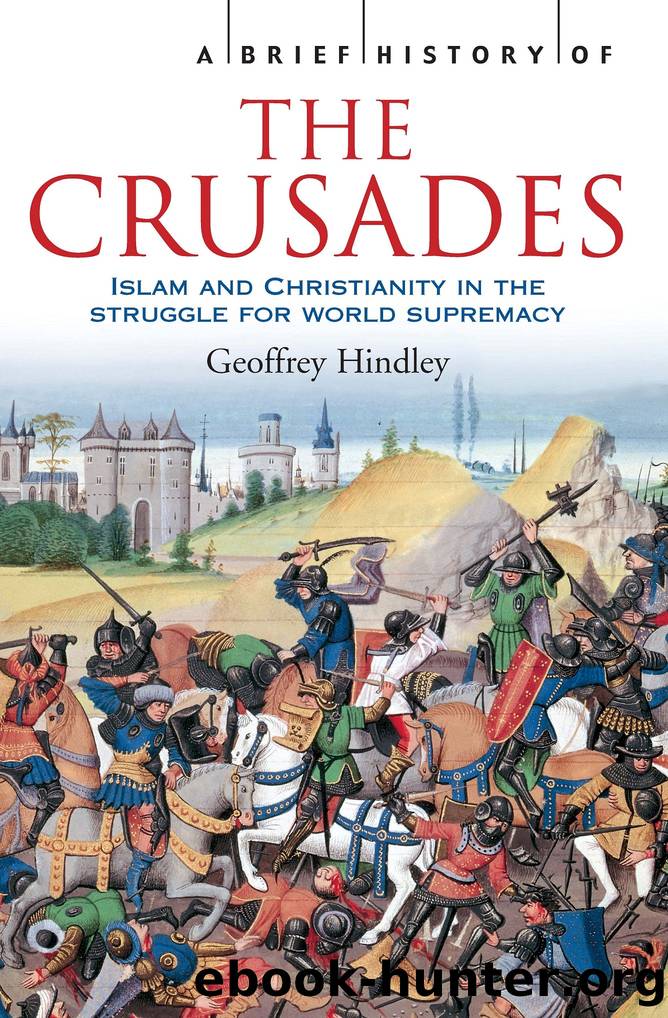A Brief History of the Crusades by Geoffrey Hindley

Author:Geoffrey Hindley
Language: eng
Format: epub
ISBN: 9781472107619
Publisher: Little, Brown Book Group
Published: 2013-12-08T16:00:00+00:00
9
Heathen, Heretics and Children
In all, Pope Innocent III initiated five crusades. Of these the most successful was the one in which the Popeâs participation was the least. In the spring of 1212 the Archbishop of Toledo persuaded Innocent to proclaim crusading indulgences for the campaign being mobilized by the Christian kingdoms of Spain against the Muslim Almohad Empire which ruled the southern half of the peninsula. The gradual recovery of the former Christian territories, the Reconquista, had been in progress since the original Moorish conquests some 500 years before. Urban II himself had extended the newly introduced crusading privileges to these Iberian campaigns and during the twelfth century various popes had proclaimed crusades there. For the most part, however, the Spaniards and Portuguese received little help from the rest of Europe, though the capture of Lisbon during the Second Crusade was a notable exception to the rule. In the 1160s and 1170s the military religious orders of Avis, Santiago and Alcantara were formed on the model of the Templars and Hospitallers, both of which received endowments from the various Spanish rulers. But although the church of Vera Cruz near Segovia, built by the Templars to house a portion of the True Cross, was a reminder of the Orderâs exertions in the Holy Land, its efforts remained directed away from the Iberian conflict. Thus when Innocent proclaimed the crusade for King Alfonso VIII of Castile, leader of the Christian coalition, the call was taken up by a few Templars and French knights, but the bulk of the army was Spanish. In July 1212 it won a crushing victory at Las Navas de Tolosa in southern central Spain, which began the break-up of Almohad power.
Of Innocentâs other four crusade initiatives, he saw only one through from beginning to end and the result, although it meant the extension of Romeâs authority in the lands of the Eastern Orthodox Church, was hardly the outcome which had been envisaged by the pontiff. Determined to make good the travesty of his plans contrived by the leaders of the expedition that had set out from Venice and ended up as conqueror of Constantinople, in 1213 Innocent commissioned the preaching of another, sometimes called the Fifth Crusade. He died before the campaign opened and its progress will be traced in the next chapter. The two other ventures in the âbusiness of the Crossâ which this pope set in motion opened the crusading movement in two directions we have not explored so far â war against nonbelievers other than Muslims and war against misbelievers, those who might consider themselves Christians but whom Rome considered heretics or perverters of the faith. But all these enterprises, whatever the declared enemy or eventual outcomes, were crusades as the term is understood since all were under the aegis of the Pope and all, promoted by increasingly well-organized campaigns of propaganda, heightened public awareness of militant pilgrimage in the cause of Christ and His Cross.
With only slight exaggeration one could say that in early thirteenth-century Europe crusading was in vogue and crusading fever was in the air.
Download
This site does not store any files on its server. We only index and link to content provided by other sites. Please contact the content providers to delete copyright contents if any and email us, we'll remove relevant links or contents immediately.
| Africa | Americas |
| Arctic & Antarctica | Asia |
| Australia & Oceania | Europe |
| Middle East | Russia |
| United States | World |
| Ancient Civilizations | Military |
| Historical Study & Educational Resources |
Magic and Divination in Early Islam by Emilie Savage-Smith;(1498)
Ambition and Desire: The Dangerous Life of Josephine Bonaparte by Kate Williams(1343)
Bohemians, Bootleggers, Flappers, and Swells: The Best of Early Vanity Fair by Bohemians Bootleggers Flappers & Swells- The Best of Early Vanity Fair (epub)(1341)
Papillon by Henry Charrière(1307)
Twelve Caesars by Mary Beard(1254)
Operation Vengeance: The Astonishing Aerial Ambush That Changed World War II by Dan Hampton(1134)
What Really Happened: The Death of Hitler by Robert J. Hutchinson(1127)
London in the Twentieth Century by Jerry White(1111)
Time of the Magicians by Wolfram Eilenberger(1086)
The Japanese by Christopher Harding(1084)
Twilight of the Gods by Ian W. Toll(1083)
Lenin: A Biography by Robert Service(1042)
The Devil You Know by Charles M. Blow(984)
A Social History of the Media by Peter Burke & Peter Burke(936)
Freemasons for Dummies by Hodapp Christopher;(921)
Napolean Hill Collection by Napoleon Hill(902)
Henry III by David Carpenter;(890)
The Churchill Complex by Ian Buruma(879)
The Rise and Triumph of the Modern Self by Unknown(877)
